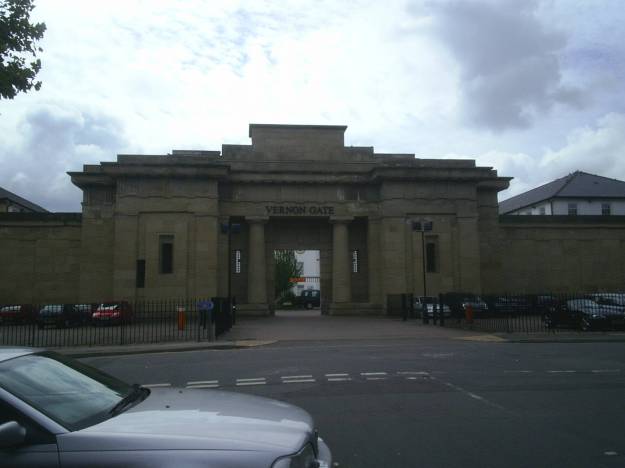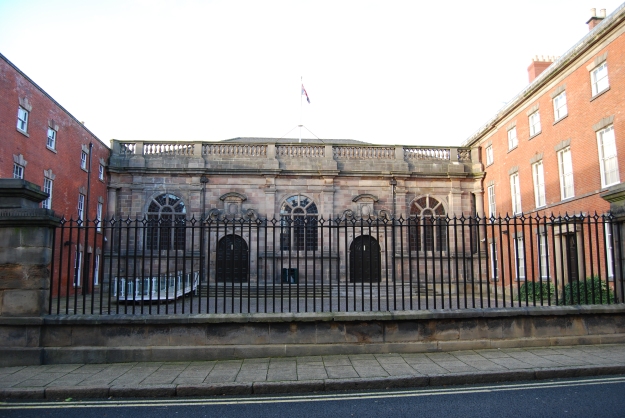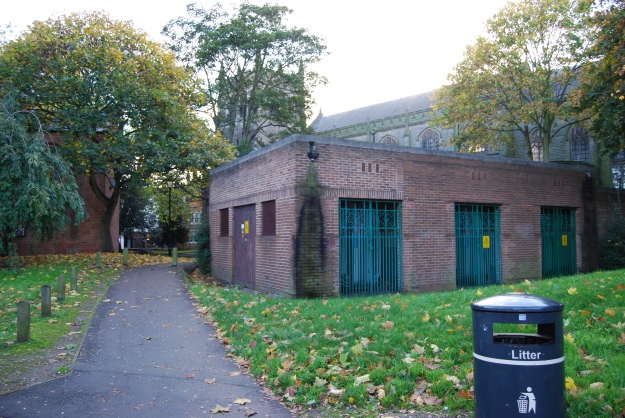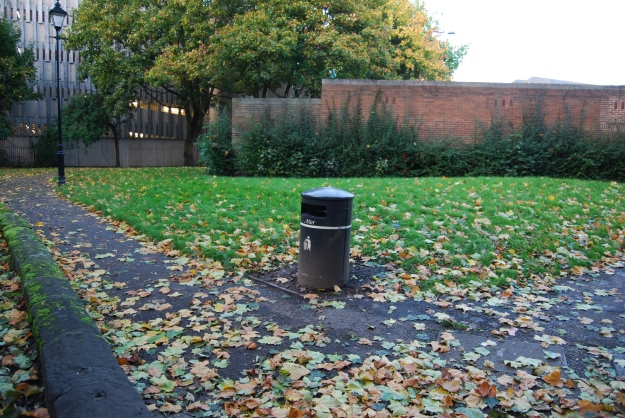The current form of this post was provoked by the final episode last night (28 Dec. 2013) of the BBC seasonal costume fest for 2013: the three-part adaptation of PD James’ Death Comes to Pemberley.[i] The drama takes up the story of Jane Austen’s Pride and Prejudice, and in doing so is set and filmed in Derbyshire.[ii] This in particular piqued my interest, considering that crime and punishment in the County (including Derby – in which I’m especially interested) is featured in the story.[iii]
I don’t intend to attempt a critique of the historicity of either Austen, or of the general historical in/accuracy of this BBC drama (there are many more knowledgeable, who would do a far better job at this, than I). Rather, there are a few aspects of the programme that may provide a springboard to present (local) information on the topic, and relevant resources.[iv]
Derby Assizes
The scene of Derby Assizes, which I’m guessing was filmed at nearby Buxton[? I’ve not had chance to check], was somewhat disappointing – it certainly presented a very different impression of the landscape of early 19th century Derby. Despite losing historic buildings between the 1930s – 70s, due to the many (IMHO) ill-advised acts of local authority vandalism urban ‘improvement’ schemes, much of the early court buildings still stand. The buildings are located at the bottom of St Mary’s Gate, and mostly retain a legal function, acting as the Magistrate’s Court:[v]
Google Map of the area in which the courts are located
The buildings (originally constructed during the mid 17th century, although modified during the early and late 19th century, and in the 20th century) are clearly recorded on the 1801 map of Derby as ‘County Hall’, and were also known as ‘Shire Hall’; the Derbyshire Historic Environment Records (HER) are (very usefully and freely) available online, and record the history of these (and 0ther) buildings here.
The Assizes (for serious crimes; lesser crimes were heard at Petty Sessions), were held Quarterly (Spring, Summer, Autumn, Winter), and usually began with much public pomp and circumstance. A local newspaper, the Derby Mercury, records on many occasions how the High Sheriff of the County and his entourage would meet at his home with significant local landowners (who acted as local Justices and Magistrates), who would be received and suitably refreshed in style. The company would process in carriages and on horseback from his estate (usually located on the outskirts of the town), often accompanied by numerous mounted guards – and fanfare – to the County Hall (as intended, attracting a crowd). In later years, with the development of the railways, judges travelling from out of town on the legal circuit were met en route.
An example of early 19th century Assizes hearings is reported in The Derby Mercury (Thursday, March 23, 1809):
“On Monday, Sir John Bayley, KNT, one of the Justices of the Court of Common Pleas, arrived here. His Lordship was attended into the town by Charles Upton, Esq. High Sheriff, accompanied by a numerous assemblage of Gentlemen of the county and town. After his Lordship had opened the commission of the assizes, he attended divine service at All Saints’ church, where an appropriate sermon was delivered by the Rev. Jo[b?] Bradshaw.
At these Assizes the following prisoners have taken their trials, viz. William Varley, for having his custody, 21, and John Wigley, 48 forged Bank of England one pound notes, were ordered to be transported, 14 years each; James Taylor, for stopping Mr. William Storer, of this town, butcher, on the King’s highway, with intent to rob him, to be transported 7 years; Thomas Stanley, for stealing a quantity of deer skims, and John Hancock for breaking into the counting house at Birley Moor Colliery and stealing various things thereout, the former to be imprisoned two years and fined 2s., and the latter to be imprisoned 6 calendar months and fined 1s. William Robinson, for stealing a drake, to be imprisoned 1 year, and publicly whipped 100 yards; Samuel Wragg, for stealing a barn door fowl, to be imprisoned 1 month and fined 1s. William Fisher and Joseph Eyre, charged with stealing fowls, both acquitted; and Joseph Bell was admitted evidence against the said William Fisher and Joseph Eyre; John Straight, charged with [uttering?] a forged one pound note of the Bank of England, was acquitted; and against Joseph Hodgins, changed with stealing a pocket book, no bill was found.” [vi]
The fate of the condemned man (or woman, or child) – and their remains
On conviction, criminals of the early 19th century were imprisoned at the mid 18th century Friar Gate Gaol (now a tourist attraction; for a while my mum had a shop that was reputedly in one of the cells – which was a little weird, but proved interesting…). [vii] Those given the death sentence were publicly hanged outside the court, and between mid 18th century and 1832, the corpses of murderers given to anatomy schools for dissection (after this time, those buried at the expense of the parish, i.e. by the workhouse authorities, became ‘specimens’ and provided ‘practice’ for medical students). There has been some interesting research on this particular topic – including some great archaeological work; inevitably, I’m interested in the fate of the cadavers of Derby criminals, and have begun to look into this by trawling through parish records (extracts from which have been transcribed in previous posts).[viii]
Friar Gate Gaol
The remains of criminals were buried in (or rather adjacent) the Parish graveyard – at nearby St Werburgh’s Church, located in the present site of the electric sub-station, and towards the Bold Lane multi-story car-park (not far from the courts in St Mary’s). A number of these burials were reputedly encountered during demolition of 19th century domestic and retail buildings (constructed above the burials), several decades ago, and were fortunately photographed; I hope to scan and post some of the photos taken by Derek Palmer during these works (thanks to Derek Palmer of the Derby Heritage Forum for information on this site, which includes observation of the presence of what appeared to be lime in association with the remains).
Above and Below: approximate site of the ‘criminal’ burial ground, St Werburgh’s Churchyard (photos: author)
Location of St Werburgh’s burial ground
In 1817, the gaol was reported as being inadequate, and after collections of rates, the New County Gaol was opened in 1827, in South Street, at the end of Vernon Street, it’s western wall siding Uttoxeter Old Road.[ix] (A previous post transcribes the 1911 census of prisoners and workers in this gaol, and provides images of some of the remaining features.) It is against the eastern walls of this prison that my first home (a mid 19th century four-room house) was located, which provoked my interest (and imagination!) from an early age in the lives of prisoners and prison workers in the area in previous generations (see previous post and post elsewhere). Criminals that died in gaol were buried within the prison grounds; I need to do some archive digging to determine whether any were excavated during any of the phases of development on the site – if not, they remain buried below the offices recently built within the complex.

South Street New County Gaol (photo: author – I’ll nip along to take a better one soon, to replace this poor iPod version…)
Location of New County Gaol
I’ll post more information as I compile and interpret data.
A few additional resources to be going on with…
- DCC Prisoner Records
- Derbyshire Prisoner / Trial / Conviction / Court Records
- Michael Cox’s ‘Crime in Derbyshire 1770-1828. Cases from Derbyshire Petty and Quarter sessions 1770-1828’ website transcribes several thousand prisoner records
[i] Due to an imminent abstract deadline, and overdue article submission, this will be a short post regarding a topic on which I had hoped to spend more time: Crime and Punishment in 19th Century Derbyshire
[ii] Like the BBC’s 1995 adaptation of P & P, DCP was filmed at the County’s best known Country House and Estate, Chatsworth, Chatsworth House represents Pemberley (for the 1995 drama, interior shots were filmed in another Derbyshire Country House, Sudbury Hall). The BBC selected locations due to links between Austen’s work and locations in the County – particularly the belief that the fictional Pemberley Chatsworth was based upon the House (as noted here).
[iii] I’ve begun to post information and data on the topic of Crime and Punishment in Derby here. See a previous post for a brief outline of my family (and my own) history of living adjacent Derby County Gaol, which have stimulated my interest this field of research; descriptions of this housing are posted here
[iv] See above note regarding the previous post, which mentions other work on Crime and Punishment in Derbyshire in the past
[v] Excavations on nearby Bold Lane (the reports available here and here) revealed medieval and post-medieval activity, as illustrated on early maps (e.g. available here). For those interested in earlier history, excavations were carried out to the rear of the court, revealing Medieval and later material (the report available here)
[vi] Further newspaper articles can be found via Newspaper Archives (such as that held by the British Library), although online access requires subscription or the purchase of pay-as-you-go credits.
Online collections include: British Newspapers 1600-1950; 19th Century British Newspapers; NewsVault ; 17th and 18th Century Burney Collection; 19th Century UK Periodicals; Eighteenth Century Collections Online; The Times Digital Archive. (If I had more time, I’d transcribe the rather interesting case from the Summer Assizes: a health & safety compensation claim that drew the crowds!) .
[viii] Ruth Richardson’s Death, Dissection and the Destitute provides an interesting account of the history of medical dissection. The MoLA monograph Doctors, Dissection and Resurrection Men, by Natasha Powers et al., is sadly hard to find, but a superb archaeological investigation of dissected remains.
[ix] Designed by the architect Francis Goodwin



